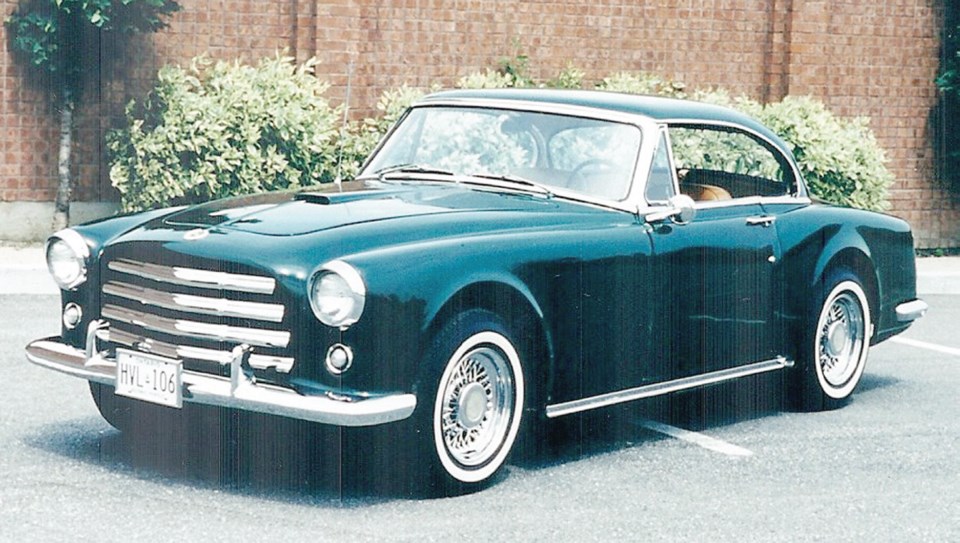The pent-up demand for new cars attracted several would-be car-building entrepreneurs following the Second World War. Kaiser-Frazer was the most successful, but even it would ultimately fail after producing cars for 10 years in the United States and a short time in Canada. Others included Tucker, Playboy, Muntz and Cunningham, all of which soon disappeared.
Another was Sterling Edwards of California. Edwards was born into a prosperous family engaged in the manufacture of wire rope in San Francisco. He worked as a pilot for Lockheed during the war, giving newly built planes their initial test flights. Among them was the P-38 Lightning, whose twin tail boom rudders inspired the 1948 Cadillac tailfins.
In 1948, during a trip to Switzerland, the 30-year-old Edwards was captivated by the Italian Cisitalia sports car. He began formulating the idea of building a similar car for the American market long before the appearance of the Chevrolet Corvette or Ford Thunderbird.
Edwards was also becoming interested in the sports-car racing that was emerging in North America with imported cars such as MGs, Healeys, Jaguars, Allards and Ferraris.
Before attempting a similar production car, he hired some talented craftsmen to build a sports racer using American components as a kind of test bed.
A ladder-type tubular frame and undercarriage was constructed, its most advanced feature being four-wheel independent suspension. The front was conventional Studebaker A-arms and coil spring, and the rear was trailing arms and torsion bars similar in layout to the Volkswagen and Porsche. Fully articulated axles were used, not the VW/Porsche’s swing axles.
Parts came from various cars, including the Studebaker A-arms and brakes and Ford transmission. The engine was a modified Ford V-8 60, the smaller 2.2-litre version of Ford’s 1937 to 1940 side-valve V-8. With modifications such as higher compression and twin carburetors, it developed a reputed 120 horsepower in the Edwards, twice its original 60. The car was fitted with an attractive aluminum body.
The first Edwards was completed in 1950, and immediately launched its racing career by winning the four road races it entered. Encouraged by this, but seeking more power, in 1951 Edwards fitted the small Ford V-8 with an Ardun overhead valve conversion (conceived by Zora Arkus-Duntov, the Corvette’s first engineering “father”). This raised horsepower to approximately 135.
It still wasn’t enough to counter the Farraris and Allards then becoming popular, so Edwards began building a new car based on a Kaiser-Frazer Henry J 2,540-millimetre-wheelbase chassis. It had modified aircraft disc brakes and Chrysler’s new 5.4-litre “Hemi” V-8.
Edwards fabricated a body out of an emerging glass-reinforced-plastic material called fibreglass. In this he predicted the fibreglass bodies of both the Kaiser-Darrin and Chevrolet Corvette.
When the second car proved far less successful in competition than his first, Edwards turned to racing faster European cars such as Ferraris and Jaguars. But he continued developing a production sports car using American components.
He established the Edwards Engineering Co. in South San Francisco, and the first production prototype Edwards America, named to emphasize its American ancestry, was ready in 1953. The low, handsome two-seater convertible had an Oldsmobile “Rocket” V-8 driving through a GM Hydra-Matic transmission. Its body was fibreglass, as were all subsequent Edwards Americas.
Edwards got some welcome publicity when Road & Track featured it in January 1954, summing it up thus: “Here for the first time is a practical sports car that combines reliable American components, high performance, styling that shows the Italian influence and a reasonable price.”
Based on this prototype, he produced the second road-going Edwards America, a coupe built on a reinforced Ford station-wagon frame with the wheelbase reduced from its original 2,997 mm to 2,718. A Lincoln V-8 was used instead of Oldsmobile, although Hydra-Matic was retained.
In response to a specific order, Edwards America No. 3 had Cadillac power. It was a convertible, the only other open car built besides the prototype. Edwards America No. 4 went back to Lincoln power, while No. 5 was again fitted with a Cadillac engine.
No. 5 was the last production Edwards America, although one more was half completed. The end came in 1954 when Edwards suffered the usual fate of startup car companies: lack of capital. There was also sales resistance, as the Edwards America’s price had climbed to nearly $8,000, more than twice that of a new Corvette.
Thus another aspiring automobile entrepreneur’s dream ended, and remains a small footnote in automotive history. Fortunately, most Edwards Americas have been preserved and stand as a reminder of one man’s vision of what a true American sports car should be.
